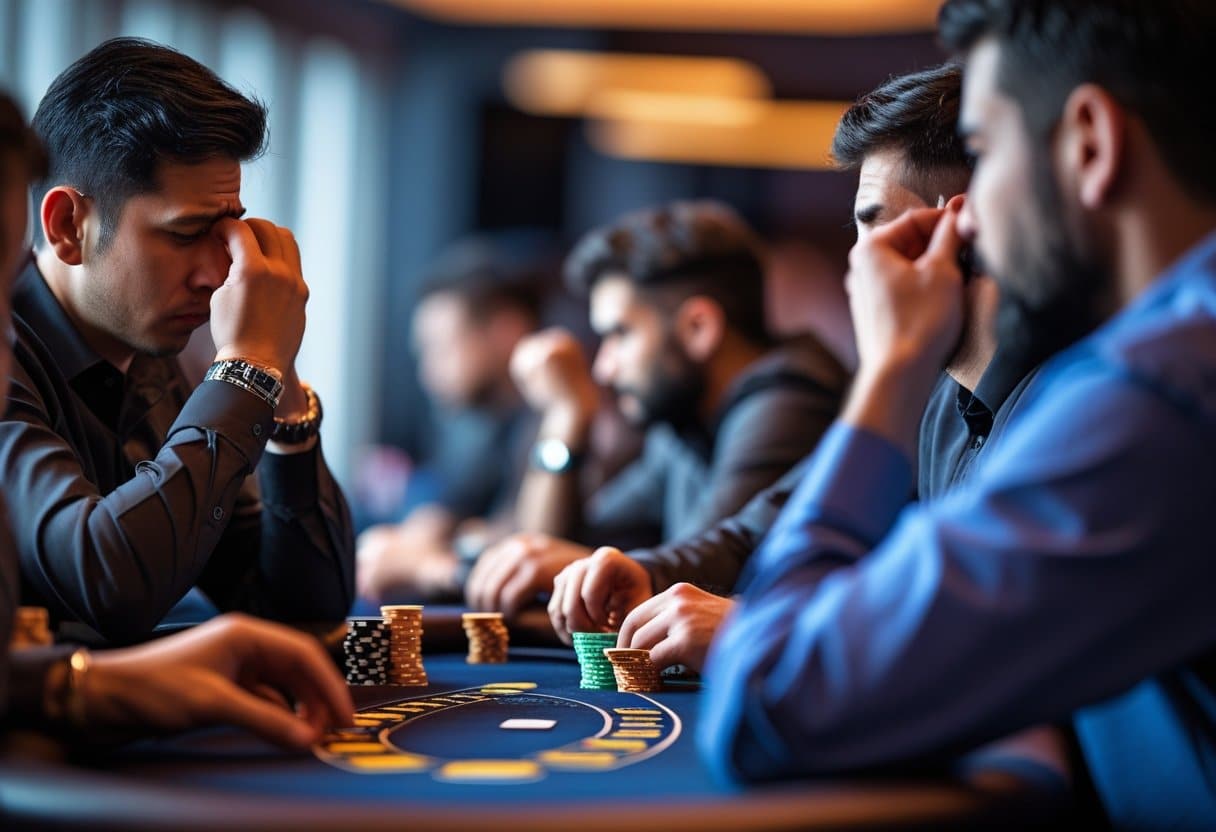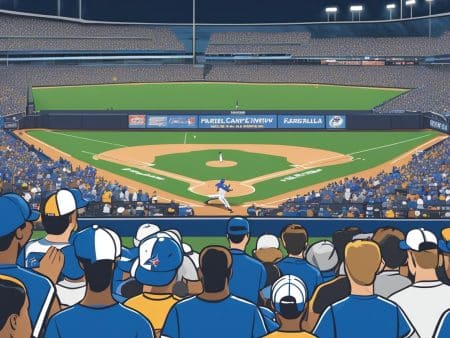Poker’s a game of strategy, psychology, and—let’s be honest—just watching people. Cards and chips might hog the spotlight, but the real gold is in the players themselves.
If you can spot when someone’s bluffing, you’re not just playing poker anymore. You’re playing people.

Being able to recognize bluffing tells—those little physical and behavioral giveaways—really separates the sharks from the fish. These signs could be anything from quick bets to a sudden stiff posture, nervous glances, or even just someone getting uncharacteristically quiet.
It’s not just about catching lies, either. It’s about piecing together how your opponents actually play.
Even the best players slip up and reveal something through their betting, their posture, or the way they handle their chips.
Spotting these patterns gives you a real edge. You’ll know when to call, when to walk away, and when to go for the jugular.
Fundamentals of Poker Tells

Poker tells are those sneaky little signs that leak info about a player’s hand. If you can pick up on these cues, you’ll make way better decisions at the table.
Understanding Poker Tells
A poker tell is any physical or behavioral sign that tips you off to the strength (or weakness) of someone’s hand.
These things usually happen without the player realizing—stress, excitement, or just plain nerves can bring them out.
You’ll see stuff like shaky hands, weird breathing, or someone talking in a way that just feels… off. Players with big hands look relaxed. Bluffers? Not so much—they might overdo it or get jumpy.
Most people have their own patterns. If you watch someone over a few hands, you’ll start to catch what’s normal for them and what’s not.
Biggest tells usually show up when there’s a lot of money on the line or the pressure’s cranked up.
Physical Tells Versus Online Cues
In live poker, you get the classics: facial expressions, body language, and how someone talks.
If a player suddenly won’t shut up during a hand, they’re probably trying to distract you from their nerves.
Eyes give away a lot too. Strong hands? Players often look away. Bluffers might stare you down or obsess over their chips.
Online, you don’t get that. Instead, timing tells are huge—fast calls can mean weakness, and instant raises might scream strength.
Bet sizes and chat behavior can also tip you off. Weird bet amounts or sudden changes in betting style usually mean someone’s unsure about their hand.
Why Bluffing Indicators Matter
Spotting when someone’s bluffing can seriously boost your profits. If you nail a tell, you can call with hands you’d normally fold, or avoid paying someone off when they’re actually strong.
It also helps you clean up your own game. Knowing what people look for lets you hide your own tells better.
There’s a psychological edge too. Once people realize you can read them, they start playing differently—and often, not as well.
15 Subtle Signs Your Opponent Is Bluffing
Catching a bluff can turn a session around. These signs aren’t always obvious, but if you know what to look for, they’re surprisingly reliable.
Sudden Changes in Betting Patterns
When someone who’s been playing it safe suddenly throws out a big bet, it usually means they’re trying to scare you off.
If a player checks and raises out of nowhere after being passive, that’s a red flag. They’re probably not sitting on aces.
Bluffers might also bet weird amounts—like overbetting the pot—to look strong.
If someone’s been quiet for an hour and then starts firing, ask yourself: are they really holding the nuts, or just trying to steal?
Irregular Bet Sizing
Bluffers get weird with their bet sizes. A strong player knows exactly how much to bet, but bluffers? Not so much.
Tiny bets are often a sign of weakness—they just want you to fold so they don’t have to risk more.
Huge bets can be bluffs too. If someone bets way more than necessary, they’re probably hoping you’ll just back off.
Look for round numbers. If someone bets exactly $100, they’re not thinking about value—they’re just trying to look like they are.
Fast, oversized bets can be a giveaway too. It’s almost like they’re trying to muscle you out before you think it through.
Unusual Timing Tells
How fast someone acts can speak volumes. Bluffers often act quickly when a card hits that’s supposed to help them.
If someone hesitates, then suddenly bets big, they might be trying to look strong but are actually weak.
Instant calls early, then aggression later? That’s often a pre-planned bluff.
Timing that’s out of character is always suspicious. If a quick player slows down, or a slow one speeds up, something’s off.
Dramatic sighs or fake frustration before a big bet? That’s usually theater.
Shifts in Body Language
Live poker is all about reading people. If someone stiffens up after betting, they’re probably nervous.
Eye contact can be telling. Too much or too little—either way, it can mean a bluff.
Watch their breathing. Deep or rapid breaths, or someone trying to control their breath, are classic signs of stress.
Fidgeting ramps up during bluffs—chip tricks, touching their face, all that.
Speech changes too. If someone suddenly won’t stop talking, or goes silent, take note.
Behavioral and Psychological Clues
Poker’s as much about people as it is about cards. Sometimes, you’ll pick up on things your opponent doesn’t even realize they’re doing.
Signs of Nerves or Discomfort
Bluffers get nervous, and it leaks out. Sudden stillness, throat clearing, or a big swallow before betting are all signs they’re uncomfortable.
Tension in the jaw or mouth is a classic stress indicator.
Watch the eyes—rapid blinking or avoiding your gaze can mean they’re hiding something. On the flip side, forced staring is just as suspicious.
Some players get visibly flushed or pale when they’re under pressure. It’s just a biological reaction to stress.
Overly Confident Table Talk
When someone suddenly gets chatty, they might be trying to distract you from their weak hand.
Listen for changes in their voice—higher pitch, shaky, or even an overly deep tone can all be tells.
Common things to listen for:
- Explaining their bets when nobody asked
- Fishing for your reaction (“You should fold, you know”)
- Giving you a play-by-play of their thinking
- Saying things that don’t match what they’re actually doing
If a normally talkative player clams up, they’re probably focusing hard on keeping up their bluff.
Rapid Breathing and Fidgeting
People can’t always hide their nerves. Fast, shallow breaths or holding their breath after betting are clear signs of anxiety.
Watch their hands—touching their face, messing with chips, tapping, or even adjusting their clothes for no reason.
Everyone’s got their own baseline. The trick is catching when someone suddenly changes their usual behavior. A hyper player going still, or a calm player getting twitchy, both mean something’s up.
Microexpressions and Eye Contact
Microexpressions are those blink-and-you-miss-it facial movements that spill the truth before someone can hide it.
Eyes are a goldmine. Pupils get bigger with excitement or stress. That can mean a big hand—or a big bluff.
Notice when they look at their chips. Players planning a bet often glance down when they’re strong.
Eye contact that feels forced or completely absent is a red flag. Both extremes usually mean discomfort.
If one side of their face looks different—tighter, maybe—it could be a sign of internal stress.
Game Context and Situational Tells
Spotting bluffs isn’t just about reading faces. The game’s structure, stack sizes, and even your position at the table all matter.
Effect of Stack Sizes on Bluffing
How many chips someone has changes everything.
Deep stacks (over 100 big blinds) give players room to bluff big. They can recover if it goes wrong.
Short stacks (under 20 big blinds) usually don’t bluff much—if they do, it’s often all-in and desperate.
Medium stacks are wildcards. They’ve got enough chips to make moves, but they still feel pressure.
Good players pay attention to stack-to-pot ratios (SPR). High SPR means more bluffing opportunities, since there’s more at risk.
Player Position and Commitment
Where you sit at the table affects how likely someone is to bluff. Late positions (button, cutoff) bluff more—they’ve seen what everyone else does first.
If a player’s already put a big chunk of their stack in, they’re less likely to bluff. That’s pot commitment—they’re invested, for better or worse.
Continuation bets after the flop are classic bluff spots, especially if the board looks bad for the pre-flop raiser.
Players bluff more when the board “looks” like it should help their range, even if it didn’t.
Tournament Versus Cash Game Dynamics
Tournaments and cash games are totally different animals.
As blinds go up in tournaments, short stacks get desperate and bluff more.
Cash game players tend to be more careful—they can always buy back in, so there’s less wild bluffing.
On the tournament bubble, big stacks bully the medium stacks with bluffs, knowing those players just want to survive.
ICM pressure makes people fold more, which creates juicy bluffing spots for those paying attention.
Short-Stacked Pressure Plays
Short stacks have their own patterns. When they shove all-in, it often takes less of a hand as their stack shrinks.
They’re banking on “fold equity”—having enough chips to make others think twice, but not so many that a call is devastating.
With short stacks, timing is everything. Quick all-ins usually mean strength. Hesitation before shoving? That’s often a bluff or a weak hand.
Once a player drops to around 10 big blinds, they enter “push/fold” mode. Bluffing gets more mathematical, less psychological.
Adapting Your Strategy to Recognize Bluffs
You’ve got to adjust your read based on who you’re up against and what’s happening at the table.
Incorporating Game Theory into Bluff Detection
Game theory’s not just for math nerds—it actually helps you make better calls.
Balance your own play between being predictable and exploiting your opponents.
Instead of trying to guess one exact hand, think about their whole possible range.
Bet sizing tells you a lot. Some people bet small with bluffs, big with value, or sometimes the other way around. Patterns like that are pure gold.
Minimum defense frequency is a handy concept. It means calling just enough so your opponents can’t bluff you profitably, but not so much that you’re giving away chips.
Keep tabs on how often your opponents bluff in certain spots. Most people don’t bluff enough in some situations and go overboard in others.
Countering Regulars and Skilled Poker Players
Skilled players are just tough to read. They know all about the usual tells and do their best to hide them.
When you’re up against regulars, it’s smarter to focus on their betting patterns instead of trying to spot physical tells.
Even online, timing tells can sneak through. Sometimes a lightning-fast bet shows strength, but with some players, it could mean the opposite.
Try paying attention to how they handle similar spots. Most regulars stick to their default strategies and rarely mix things up.
Bet sizing is a big one. Even good players mess up and use different sizes when they’re bluffing versus when they’ve got the goods.
Using a balanced calling range can help against these folks. It makes it harder for them to run over you with perfectly timed bluffs.
Don’t get caught up looking for obvious tells with regulars—they know what you’re looking for and might even use fake tells to throw you off.
Exploiting Bad Players’ Mistakes
Inexperienced players? They’re usually way more transparent. You might notice them talking a lot more when they’re bluffing, or maybe they’re visibly nervous.
Their betting just doesn’t add up sometimes. Bad players often bet too small when they’re bluffing, probably because they’re scared.
You really want to follow their story as the hand plays out. If their bets don’t fit the way the board developed, odds are they’re just making it up.
Ever notice someone suddenly going silent or, on the flip side, getting super chatty? Those swings in behavior can be a huge giveaway.
Most recreational players don’t like bluffing into a crowd. If a weaker player suddenly throws out a big bet against a bunch of people, they’ve almost always got it.
Their past behavior is a goldmine. Casual players love their habits and tend to repeat the same moves when they’re bluffing.
Mastering Poker Tell Recognition for a Winning Edge
Getting good at reading poker tells isn’t something that happens overnight. It takes a lot of practice, a willingness to dig into the technical side, and honestly, some psychological grit.
You need to keep a close eye on your opponents, but don’t forget to manage your own behavior and mental game, too.
Developing Self-Awareness and Tilt Control
Self-awareness is such a big deal here. If you know your own quirks, you can keep from giving away too much at the table.
Try recording and reviewing your own play. It’s not always fun, but it helps.
Track how you’re feeling during sessions. Sometimes your emotions are louder than you think.
Practicing a neutral expression in the mirror? Yeah, it feels silly, but it works.
Tilt control matters just as much. Once your emotions take over, good luck reading anyone.
Take deep breaths between hands. Sometimes that’s enough to reset.
Set a “stop-loss” rule for when you start playing on tilt. It’s tough to stick to, but it pays off.
Visualization during breaks can help, too. Just imagining yourself calm can make a difference.
Having a healthy bankroll takes the edge off. If you’re not worried about going broke, it’s so much easier to think clearly.
The Role of Coaching and Poker Books
A good coach can seriously speed up your progress. They catch stuff you don’t even realize you’re doing.
They’ll give you honest feedback and keep you accountable, which is honestly priceless.
Poker books still have value. “Reading Poker Tells” by Zachary Elwood and “Caro’s Book of Poker Tells” are classics for a reason.
But don’t just stick to the old stuff. Online courses with video analysis are great for seeing real tells in action.
Study groups are underrated. Talking through hands and tell patterns with other players can really open your eyes to new things.
Maintaining a Strong Mental Game
A solid mental game keeps you sharp, even when things get stressful.
Meditation—just ten or fifteen minutes a day—can do wonders.
Pre-game visualization routines help set the right mindset.
After a session, try to analyze your play without beating yourself up. It’s not easy, but it’s worth it.
Physical health matters, too. If you’re well-rested, it’s easier to stay focused and pick up on the little things.
Regular sleep and some exercise go a long way toward better performance at the table.
And hey, sometimes you do everything right and still lose. That’s just poker. Focus on making good decisions, not just chasing results.
Learning from Pros Like Phil Galfond and Doyle Brunson
Professional players have a lot to teach when it comes to spotting advanced tells. Phil Galfond, for example, really stresses the need to watch for someone’s baseline behavior before jumping to conclusions about any odd moves.
Galfond tends to focus on context above all else. He’ll point out that the same little tic or habit could mean totally different things, depending on a player’s history or what’s happening at the table.
Then there’s Doyle Brunson—he’s got decades under his belt. He talks a lot about patience in reading tells, and his classic advice is to “watch players’ hands, not their faces.” Makes sense, since tension usually shows up in body language first.
Brunson’s seen poker tells evolve over the years. The way he adapts as players get savvier just proves you can’t lean on old tricks forever; you’ve got to keep your tell-reading game fresh.
Something both Galfond and Brunson agree on: tells aren’t universal. Online games, live games, high-stakes tables, or casual nights with friends—each setting has its own quirks when it comes to reading people.











